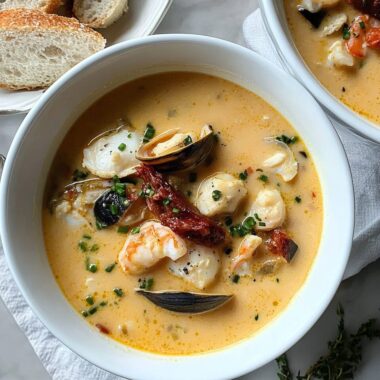Experience the heartwarming essence of Irish cuisine with this traditional Bacon and Cabbage recipe. Tender wedges of green cabbage are simmered alongside savory thick-cut bacon and sweet onions, all infused with the subtle heat of mustard seeds. This harmonious blend creates a dish that’s both comforting and flavorful, embodying the simplicity and richness of Ireland’s culinary heritage. Ideal for a cozy family dinner or a festive St. Patrick’s Day celebration, this one-pot meal is as straightforward to prepare as it is satisfying. The combination of crispy bacon, tender cabbage, and aromatic broth offers a taste experience that’s both hearty and wholesome. Serve it with a side of crusty bread to soak up the flavorful juices, and you’ve got a meal that’s sure to become a beloved favorite.
Full recipe:
Ingredients:
- 24 ounces thick-cut bacon
- 1 large green cabbage
- 1 large onion
- 2½ cups chicken broth
- 1 tablespoon mustard seeds
- Salt and black pepper to taste
Directions:
- Place a large stockpot over medium heat. Cut the bacon strips into four pieces each. Separate the bacon pieces and place them in the pot. Stir and cook until the bacon is done but not fully crispy.
- Meanwhile, peel the onion and cut it into eight wedges. Then cut the cabbage in half and remove the core. Cut the cabbage into 12 wedges. Once the bacon is mostly cooked, add the onion to the pot and sauté for 3–4 minutes to soften.
- Add the cabbage, chicken broth, and mustard seeds. Stir to move the cabbage to the bottom of the pot and bring the bacon upward.
- Cover and simmer for 15–20 minutes, until the thickest parts of the cabbage are tender. Stir once or twice while cooking. Taste, then add salt and pepper as needed.
Prep Time: 5 minutes | Cooking Time: 30 minutes | Total Time: 35 minutes
Kcal: Approximately 400 kcal per serving | Servings: 8
Irish Bacon and Cabbage: A Classic Hearty Irish Dish
Irish Bacon and Cabbage is one of the most beloved dishes in Irish cuisine, embodying the warmth, simplicity, and heartiness of traditional Irish home cooking. This dish has stood the test of time, originating from centuries-old cooking methods and remaining a staple in Irish households today.
The History of Irish Bacon and Cabbage
The origins of Bacon and Cabbage date back to the 17th and 18th centuries when pigs were a common livestock in Ireland. Unlike beef, which was expensive and considered a luxury, pork was more accessible to Irish farmers. Pork products, particularly salted or smoked bacon, became a key part of the Irish diet.
Cabbage, on the other hand, was an easy-to-grow, nutrient-rich vegetable that complemented the salty, fatty flavors of the bacon. The dish was traditionally prepared by boiling the bacon in a pot and adding cabbage and onions to the broth, creating a simple yet flavorful meal.
While Corned Beef and Cabbage is often associated with Irish cuisine, it’s actually more of an Irish-American adaptation. In Ireland, the traditional dish remains Bacon and Cabbage, often served with potatoes and mustard sauce.
Why Irish Bacon and Cabbage Is the Best
This dish is a perfect balance of flavors—the savory and slightly salty bacon blends harmoniously with the mild sweetness of cabbage, creating a comforting and well-rounded meal. But beyond taste, there are several reasons why Bacon and Cabbage is one of the best Irish recipes:
1. Easy to Prepare
With only a few basic ingredients—bacon, cabbage, onions, and broth—this dish is incredibly simple to make. It requires minimal prep work, making it an ideal weeknight dinner or a traditional dish for St. Patrick’s Day.
2. Nutritious and Wholesome
Despite its simplicity, Bacon and Cabbage is packed with nutrients:
- Bacon provides protein, essential fats, and B vitamins, which are important for energy and overall health.
- Cabbage is a low-calorie, high-fiber vegetable rich in vitamins C and K, supporting immune function and bone health.
- Onions offer antioxidants and anti-inflammatory properties.
- Broth enhances the dish’s nutrient content, providing hydration and minerals.
3. Affordable and Budget-Friendly
Historically, Irish households relied on simple, affordable ingredients, and Bacon and Cabbage remains one of the most budget-friendly meals. It uses readily available ingredients that are cheap yet nutritious, making it perfect for families and large gatherings.
4. Versatile and Customizable
While the classic recipe is delicious as is, there are many ways to customize and enhance the dish:
- Add potatoes to make it even more filling.
- Include carrots or turnips for extra sweetness and texture.
- Use smoked bacon for a richer, deeper flavor.
- Experiment with seasonings like thyme, bay leaves, or garlic.
5. A Taste of Irish Heritage
If you want to experience authentic Irish cuisine, this dish is a must-try. Its rustic, old-fashioned charm makes it feel like a taste of history, connecting you to generations of Irish families who cooked and enjoyed this meal.
Ingredients Breakdown: The Key to a Perfect Dish
To make an authentic Irish Bacon and Cabbage, it’s important to understand the role of each ingredient:
1. Bacon
- Irish bacon is traditionally used, which comes from the back of the pig (also known as back bacon). It’s leaner than American bacon and has a ham-like texture.
- If you can’t find Irish bacon, substitute it with thick-cut bacon, pancetta, or even ham hocks.
2. Cabbage
- Green cabbage is traditionally used for its mild and slightly sweet flavor.
- Red cabbage can also be used but has a slightly stronger taste.
- For a more tender texture, slice the cabbage thinly; for a heartier bite, chop it into large chunks.
3. Onions
- Onions enhance the overall flavor, adding a subtle sweetness that balances the saltiness of the bacon.
4. Chicken Broth
- Cooking the bacon and cabbage in broth instead of water gives the dish a richer depth of flavor.
5. Mustard Seeds
- These add a mild spice and tanginess, making the dish even more flavorful.
Step-by-Step Cooking Instructions
Follow this simple process to make a delicious Irish Bacon and Cabbage:
Step 1: Cook the Bacon
Start by cooking thick-cut bacon in a large pot until it becomes slightly crispy. This releases flavorful fat, which enhances the cabbage’s taste.
Step 2: Sauté the Onions
Add chopped onions to the pot and sauté them until they become soft and translucent. This step brings out their natural sweetness, which pairs well with the bacon.
Step 3: Add the Cabbage
Place sliced cabbage into the pot and mix it with the bacon and onions.
Step 4: Pour in Broth and Simmer
Add chicken broth and mustard seeds, then let the mixture simmer for 15-20 minutes until the cabbage is tender.
Step 5: Serve and Enjoy
Once cooked, season the dish with salt and black pepper to taste. Serve hot, alongside mashed potatoes, crusty bread, or a drizzle of mustard sauce.
Best Ways to Serve Irish Bacon and Cabbage
While this dish is fantastic on its own, it’s often served with side dishes that enhance the meal’s flavor and texture.
1. Traditional Pairings
- Mashed Potatoes: Creamy mashed potatoes are a classic accompaniment that balances the salty richness of bacon.
- Boiled Potatoes: Simple and hearty, these make the meal even more authentic.
- Irish Soda Bread: A slice of soda bread is perfect for soaking up the flavorful broth.
2. Sauce Options
To elevate the dish, serve it with:
- Irish Mustard Sauce: A tangy sauce made with Dijon mustard, butter, and cream.
- Parsley Sauce: A creamy, herby sauce that adds an extra layer of flavor.
Variations of Irish Bacon and Cabbage
While the traditional recipe remains the most popular, here are a few creative variations:
1. Modern Low-Carb Version
- Skip the potatoes and serve the dish with cauliflower mash for a keto-friendly twist.
2. Vegetarian Option
- Swap out the bacon for smoked tofu or tempeh to create a plant-based alternative.
3. One-Pot Irish Stew Style
- Convert the dish into a hearty stew by adding diced carrots, potatoes, and extra broth.
Conclusion
Irish Bacon and Cabbage is more than just a dish—it’s a symbol of Irish culture, history, and home cooking. With its rich flavors, nourishing ingredients, and simple preparation, it remains one of Ireland’s most cherished recipes. Whether you’re celebrating St. Patrick’s Day, looking for a quick dinner, or exploring traditional Irish cuisine, this dish is a must-try.








